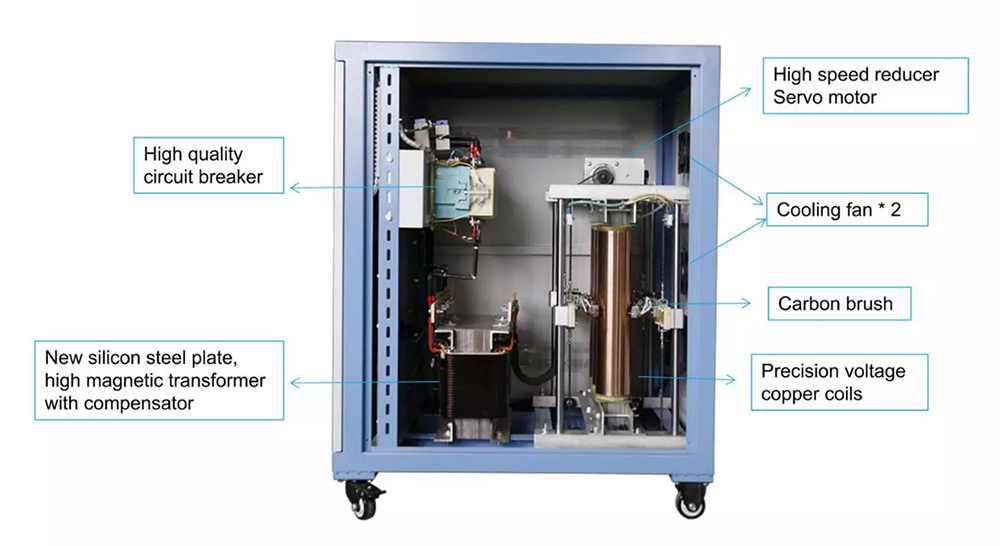A voltage stabilizer is a device that stabilizes the output voltage. The voltage stabilizer is composed of a voltage regulation circuit, a control circuit, and a servo motor. When the input voltage or load changes, the control circuit performs sampling, comparison, and amplification, and then drives the servo motor to rotate, so that the position of the carbon brush of the voltage stabilizer changes, and the coil turns ratio is automatically adjusted to maintain the stability of the output voltage. When buying a voltage stabilizer, you need to know the following technical parameters.
1. Input voltage:
The voltage stabilizer has an input voltage adaptation range. The IEC standard is for the input voltage to vary within ±20 of the rated value. If it exceeds the range, it will automatically sound and light alarm and the output voltage cannot be stabilized within the required range.
2. Output voltage regulation rate:
It is the effect of output change caused by the change of input voltage. When the load is at the rated value, the input voltage is adjusted upward from the rated value to the upper limit value and the lower limit value according to the source voltage range. Measure Maximum change in output voltage (±). The smaller the value, the better, and is an important indicator to measure the performance of the AC voltage stabilizer.

3. Load regulation rate:
It is the effect of output change caused by load change. Change the load current and measure the change (±) of the output voltage. The smaller the value, the better, and it is also an important indicator to measure the performance of the AC voltage stabilizer.
4. Relative harmonic content of output voltage:
Also known as output voltage distortion, usually expressed as THD, which is the ratio of the total RMS value of the harmonic content to the RMS value of the fundamental wave. When the load is rated, the input voltage distortion satisfies When the reference condition (generally should be less than 3), measure the output voltage distortion when the input voltage is the lowest value, the rated value, and the highest value, whichever is the largest. The smaller the value, the better.
5. Efficiency:
It is the ratio (percentage) of the output active power P0 to the input active power Pi.
6. Load power factor:
The voltage stabilizer capacity is expressed in volt-ampere (VA) or kilovolt-ampere (KVA) values. In addition to purely resistive loads, there are also inductive and capacitive loads in the load, that is, in addition to active power in the load In addition, there is reactive power. This pointer reflects the ability of the AC-regulated power supply to carry inductive and capacitive loads.
In general, for AC stabilized power supply products, the load power factor cosφ is 0.8. When the product capacity is 1kVA (apparent power), the output active power (that is, the capacity with resistive load) is up to 800W. If the product is expressed in 1KW (cosφ still 0.8), the output active power is 1KW, and the power of the voltage stabilizer is S=1000/0.8=1250VA. When the value of the load power factor is small, it means that the power supply equipment has a strong ability to adapt to reactive loads.
7. Mounting:
Since a voltage stabilizer works with electric power, there is always a risk of your stabilizer getting wet or damaged when placed on the ground or anywhere unsafe. This is why most stabilizers can be wall-mounted or placed at a higher level, to not only protect it from any damage but also protect your family, especially small children, from being exposed to the risk of electric shock.
8. Indicators:
Indicators display the voltage which has been regulated in order to supply power to the appliance. Newer models are also enabled with LED indicators.
9. Time-delay systems:
This feature enables a time-lapse so that the inbuilt compressor (in case of a refrigerator or air conditioner etc.) gets sufficient time to balance the current flow when a short duration power cut occurs.
10. Digitized:
Making the function of a stabilizer more accurate and reliable, a lot of the latest models are digitized. What’s interesting about these newer models is that not only are they digitized, but they also adapt themselves to a variety of devices. So all you have to do is shift the stabilizer from one device to another to get it to work. Most of them will also connect and adapt to generators if installed.
11. Overload protection:
The overload protection feature turns off the stabilizer output completely in case of a short circuit or any kind of burn-out due to overload occurs. Most of our stabilizers are provided with a 3-5 year warranty so that you can enjoy safe and sufficient protection for your appliances for longer. Always remember to choose a stabilizer crafted particularly for your home appliance.
